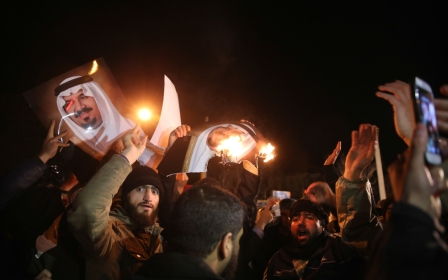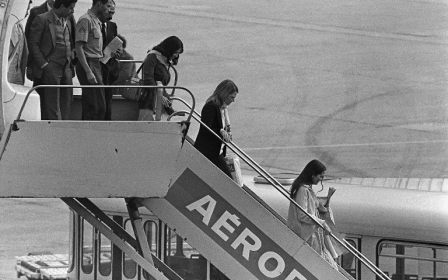Rouhani outsmarts Iran hardliners as well as the Saudis

Observers have presented different reasons behind Saudi Arabia’s execution of Sheikh Nimr Baqir al-Nimr, the outspoken cleric who spoke for Shia rights. Among these, four factors have emerged that deserve analysis.
The first factor is the emergence of the jihadi groups, primarily Daesh. The rise of such groups is considered a serious threat to the security interests of the world powers, including Western countries. To that end, the UN Security Council called on the states to fight “a global and unprecedented threat to international peace and security,” a reference to Daesh.
The Saudi Arabian regime, however, whose priority is fighting proxy wars against Iran in Syria and Yemen, has been criticised, even implicitly by President Obama, for doing too little in this respect. As a result, a recent analysis by Eurasia Group, the world's largest political-risk consultancy, maintains that “Saudi Arabia is more geopolitically isolated than at any other point in the last several decades”.
In an effort to end this isolation, the Saudis hoped to bring Iran back into the spotlight as the destabilising force in the region by provoking it to resort to a radical reaction to Sheikh al-Nimr’s execution.
The second factor that is believed to be an element in the Saudis’ decision to execute al-Nimr is the threat of intra-royal family strife. One method of containing the destabilising internal discord is for those in power to create and intensify an external conflict and thus silence the internal challenges to their power.
The third factor is the acceptance of Iran by the international community in the wake of the post-nuclear deal climate. The country is now regarded as a regional power that can be part of a realistic solution to the regions’ crises, as it has so far emerged in the Syrian case. The Saudis cannot tolerate the rise of Iran as their rival. They view Iran as a potential threat to their existence.
The fourth factor – and one that most likely played a role in the execution of al-Nimr – is the gradual shift of United States foreign policy from an unconditional Saudi ally and a perpetual adversary of the Iranian establishment, to a more sensibly balanced approach toward the two rivals. The Saudis view this US shift as being abandoned by the Americans in their struggle against a rival who is more powerful than them.
Although there still remain significant differences between Tehran and Washington on issues such as Iran-Israel relations and Iran’s efforts to expand its circle of influence in the Middle East, the new geopolitical climate in the region has created several strategic common interests and threats that push the two states toward cooperation.
The Saudis pursued three goals by executing al-Nimr. First, they wanted to send a message to Washington that if the US seeks to expand its relations with Tehran – by acknowledging and granting Tehran a greater role in the region and thus abandoning its traditional support of Riyadh in its conflict with Tehran –Saudi Arabia would take any action and adopt any policy at its choosing, and unilaterally, to confront and push back Iran with no regards for the geopolitical repercussions.
The second Saudi goal was to incite a knee-jerk reaction from Iran and inflame sectarian tensions in the region. By doing so, they intended to transform the Saudi-Iran conflict into a Sunni-Shia one and establish the Saudi position as the leader of the Sunni-Muslim world against the Iran-Shia.
The third Saudi goal was to force Washington to take its side. By doing so, Riyadh sought to disrupt improving Iran-US relations, derail the implementation of the nuclear deal, and scuttle international and US diplomatic efforts to launch a political process in Syria where Iran’s role as a major player could be established.
The ransacking and torching of the Saudi embassy in Tehran by a mob of violent demonstrators created a window of opportunity for the Saudis to realise their objectives. Many countries around the world, including the US, condemned the act.
Meanwhile, the UN Security Council condemned the attacks in the “strongest terms,” stating that Iran had violated diplomatic and consular premises, while causing serious damage.
Shortly after, Saudi Arabia severed its diplomatic relations with Tehran. Its allies followed suit, some cutting, and some downgrading their relations with Iran.
However, the damage to Iran was limited to these actions. As a result, the waves created as a result of the protestors storming the Saudi embassy were not strong enough for the Saudis to advance their objectives, primarily that of forcing the US to take a strong position against Tehran.
The primary reason the Saudis failed was Iran’s reaction to the incident. There was a flurry of condemnations by Iranian government officials, a group of 40 were arrested, Rouhani asked the judiciary chief to urgently prosecute and punish the “unruly perpetrators,” and in an unprecedented move by the Iranian government’s standards, Iran expressed “regrets” in a letter to the UN regarding the attacks. Iran did not show the fierce reaction the Saudis expected, other than exchanging heated rhetoric with the Saudis.
It is noteworthy that if a similar incident had surfaced during the tenure of the hardliner Mahmoud Ahmadinejad (2005-2013) and at the peak of the Iran’s nuclear crisis, the Americans would likely have moved quickly to impose tougher sanctions on Iran.
This time, however, something happened that was then unimaginable. Secretary of State John Kerry, from his home in Idaho, called Iran’s foreign minister, Mohammad Javad Zarif, in an effort to urge the Iranians not to escalate the situation further by retaliating, according to the New York Times.
Before and following the execution, the US has expressed disquiet regarding the human rights situation in Saudi Arabia. In addition, the EU voiced alarm about the specific case of Sheikh Nimr al-Nimr regarding freedom of expression and the respect of basic civil and political rights. The UN Secretary General raised “serious concerns” about “the fairness” of the trials.
Disappointed by the critiques, Saudi Foreign Minister Adel al-Jubeir told Reuters of the executions: "We should be applauded for this, not criticised."
As the New York Times later reported, it became apparent that the “European sympathies lean toward Iran in the conflict with Saudi Arabia.”
Saudi Arabia was denounced in the main editorial pages of both the New York Times and the Washington Post – the two leading US newspapers – for its “barbarity” and “reckless regime”. In the lead editorial, the New York Times openly accused the Saudis of “actions that blatantly fan sectarian hatreds, undermine efforts at stabilising the region and crudely violate human rights.”
That two of the most influential American newspapers have called the US’s relationship with the Saudis into question signifies that a debate has emerged at the highest level of the American political system about the future of the US-Saudi relationship.
The crisis had another distinct loser – the ultra-conservatives in Iran. Their plan was to strangle the Rouhani administration in yet another international crisis primarily aimed at provoking the US to take a hostile stance toward Iran in support of the Saudis. They hoped to create an obstacle against the implementation of the nuclear deal and revive the cycle of hostilities between Iran and the West. They failed.
Ultimately, it seems that the main winner throughout these developments has been the moderate administration of Iran. It was able to manage the crisis and direct anger and condemnations of public opinion outside of Iran toward Saudi Arabia, despite the efforts of Rouhani's rivals inside Iran to create an international predicament for him.
In the meantime, this was the first spectacular test for Rouhani’s moderate administration to demonstrate how it has been able to change the international negative climate toward Iran, which persisted for decades, following the historic nuclear agreement.
- Shahir Shahidsaless is a political analyst and freelance journalist writing primarily about Iranian domestic and foreign affairs. He is also the co-author of “Iran and the United States: An Insider’s View on the Failed Past and the Road to Peace”.
The views expressed in this article belong to the author and do not necessarily reflect the editorial policy of Middle East Eye.
Photo: Iranian President Hassan Rouhani speaks during a press conference in his office in Tehran on 16 December, 2015 (AFP).
Middle East Eye propose une couverture et une analyse indépendantes et incomparables du Moyen-Orient, de l’Afrique du Nord et d’autres régions du monde. Pour en savoir plus sur la reprise de ce contenu et les frais qui s’appliquent, veuillez remplir ce formulaire [en anglais]. Pour en savoir plus sur MEE, cliquez ici [en anglais].





